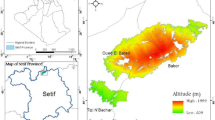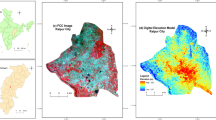Abstract
The modern cities of the world are characterized by continuous warming status. Land surface temperature (LST) is a very important part of the environmental status of mixed urban land and it is intimately associated with normalized difference vegetation index (NDVI). The current study makes an attempt on the seasonal fluctuation of LST-NDVI relation on diversified land surface material in Raipur City of India by using a large Landsat dataset for different seasons from 1991–92 to 2018–19. The results present the considerable rising trend of mean LST (1.6 °C, 5.3 °C, 4.8 °C, and 1.1 °C in the pre-monsoon, monsoon, post-monsoon, and winter, respectively) during the study period. The LST and NDVI produce a strong negative correlation (− 0.74, − 0.54, − 0.63, and − 0.49 in these four seasons) on plants; a moderate negative correlation (− 0.42, − 0.34, − 0.42, and − 0.21 in the four aforesaid seasons) on the barren land and urban settlement; and an insignificant correlation (0.27, 0.08, 0.05, and 0.19 in the four abovementioned seasons) on water bodies. This study is helpful in future planning for the ecological development of a city in tropical environment.









Similar content being viewed by others
References
Barsi, J., Schott, J., Hook, S., Raqueno, N., Markham, B., & Radocinski, R. (2014). Landsat-8 thermal infrared sensor (TIRS) vicarious radiometric calibration. Remote Sensing, 6(11), 11607–11626.
Carlson, T. N., & Ripley, D. A. (1997). On the relation between NDVI, fractional vegetation cover, and leaf area index. Remote Sensing of Environment, 62, 241–252.
Chen, X. L., Zhao, H. M., Li, P. X., & Yi, Z. Y. (2006). Remote sensing image-based analysis of the relationship between urban heat island and land use/cover changes. Remote Sensing of Environment, 104(2), 133–146.
Coll, C., Galve, J. M., Sanchez, J. M., & Casseles, V. (2010). Validation of Landsat-7/ETM+ thermal-band calibration and atmospheric correction with ground-based measurements. IEEE Transactions on Geoscience and Remote Sensing, 48(1), 547–555. https://doi.org/10.1109/TGRS.2009.2024934
Cui, L., Wang, L., Qu, S., Singh, R. P., Lai, Z., Jiang, L., & Yao, R. (2019). Association analysis between spatiotemporal variation of vegetation greenness and precipitation/temperature in the Yangtze River Basin (China). Environmental Science and Pollution Research, 25(22), 21867–21878. https://doi.org/10.1007/s11356-018-2340-4
Das, D. N., Mondal, A., & Guha, S. (2013). Change in mangrove forest cover and deltaic islands in sundarban areas of West Bengal: A temporal analyses using NCI technique on LANDSAT TM5 data (pp. 113–127). Scientific Publisher.
Du, S., Xiong, Z., Wang, Y., & Guo, L. (2016). Quantifying the multilevel effects of landscape composition and configuration on land surface temperature. Remote Sensing of Environment, 178, 84–92.
Estoque, R. C., Murayama, Y., & Myint, S. W. (2017). Effects of landscape composition and pattern on land surface temperature: An urban heat island study in the megacities of Southeast Asia. Science of the Total Environment, 577, 349–359.
Fu, P., & Weng, Q. (2016). A time series analysis of urbanization induced land use and land cover change and its impact on land surface temperature with Landsat imagery. Remote Sensing of Environment, 175, 205–214.
Gorgani, S.A., Panahi, M., Rezaie, F. (2013). The relationship between NDVI and LST in the Urban area of Mashhad, Iran. International Conference on Civil Engineering Architecture and Urban Sustainable Development. November, Tabriz, Iran.
Govil, H., Guha, S., Dey, A., & Gill, N. (2019). Seasonal evaluation of downscaled land surface temperature: A case study in a humid tropical city. Heliyon, 5(6), e01923. https://doi.org/10.1016/j.heliyon.2019.e01923
Goward, S. N., Xue, Y. K., & Czajkowski, K. P. (2002). Evaluating land surface moisture conditions from the remotely sensed temperature/vegetation index measurements: An exploration with the simplified simple biosphere model. Remote Sensing of Environment, 79, 225–242. https://doi.org/10.1016/S0034-4257(01)00275-9
Guha, S. (2021). Annual assessment on the relationship between land surface temperature and six remote sensing indices using Landsat data from 1988 to 2019. Geocarto International, 10(1080/10106049), 1886339.
Guha, S., & Govil, H. (2020). Land surface temperature and normalized difference vegetation index relationship: A seasonal study on a tropical city. SN Appl Sci, 2, 1661. https://doi.org/10.1007/s42452-020-03458-8
Guha, S., Govil, H., & Diwan, P. (2020). Monitoring LST-NDVI relationship using Premonsoon Landsat datasets. Adv Meteorol, 2020, 4539684. https://doi.org/10.1155/2020/4539684
Guha, S., Govil, H., & Mukherjee, S. (2017). Dynamic analysis and ecological evaluation of urban heat islands in Raipur city. India. J Appl Remote Sens, 11(3), 036020. https://doi.org/10.1117/1.JRS.11.036020
Gui, X., Wang, L., Yao, R., Yu, D., & Li, C. (2019). Investigating the urbanization process and its impact on vegetation change and urban heat island in Wuhan China. Environmental Science Pollution Research, 26(30), 30808–30825. https://doi.org/10.1007/s11356-019-06273-w
Kikon, N., Singh, P., Singh, S. K., & Vyas, A. (2016). Assessment of urban heat islands (UHI) of Noida City, India using multi-temporal satellite data. Sustainable Cities and Society, 22, 19–28. https://doi.org/10.1016/j.scs.2016.01.005
Lambin, E. F., & Ehrlich, D. (1996). The surface tenperature-vegetation index space for land use and land cover change analysis. International Journal of Remote Sensing, 17, 463–487. https://doi.org/10.1080/01431169608949021
Li, W. F., Cao, Q. W., Kun, L., & Wu, J. S. (2017). Linking potential heat source and sink to urban heat island: Heterogeneous effects of landscape pattern on land surface temperature. Science of the Total Environment, 586, 457–465.
Markham, B. L., & Barker, J. K. (1985). Spectral characteristics of the LANDSAT thematic mapper sensors. International Journal of Remote Sensing, 6(5), 697–716.
Marzban, F., Sodoudi, S., & Preusker, R. (2018). The influence of land-cover type on the relationship between LST-NDVI and LST-Tair. International Journal of Remote Sensing, 39(5), 1377–1398. https://doi.org/10.1080/01431161.2017.1462386
Mondal, A., Guha, S., Mishra, P. K., & Kundu, S. (2011). Land use/Land cover changes in Hugli Estuary using Fuzzy C-Mean algorithm. International Journal Geomatics and Geoscience, 2(2), 613–626.
Nichol, J. E. (2005). Remote sensing of urban heat islands by day and night. Photogrammetric Engineering and Remote Sensing, 19, 1639–1649.
Nigatu, W., Dick, Ø. B., & Tveite, H. (2014). GIS based mapping of land cover changes utilizing multi-temporal remotely sensed image data in lake Hawassa watershed Ethiopia. Environmental Monitoring Assessment, 186(3), 1765–1780. https://doi.org/10.1007/s10661-013-3491-x
Peng, J., Jia, J., Liu, Y., Li, H., & Wu, J. (2018). Seasonal contrast of the dominant factors for spatial distribution of land surface temperature in urban areas. Remote Sensing of Environment, 215, 255–267.
Qin, Z., Karnieli, A., & Barliner, P. (2001). A mono-window algorithm for retrieving land surface temperature from Landsat TM data and its application to the Israel-Egypt border region. International Journal of Remote Sensing, 22(18), 3719–3746. https://doi.org/10.1080/01431160010006971
Sandholt, I., Rasmussen, K., & Andersen, J. (2002). A simple interpretation of the surface temperature/vegetation index space for assessment of surface moisture status. Remote Sensing of Environment, 79, 213–224. https://doi.org/10.1016/s0034-4257(01)00274-7
Sobrino, J. A., Jimenez-Munoz, J. C., & Paolini, L. (2004). Land surface temperature retrieval from Landsat TM5. Remote Sensing of Environment, 9, 434–440. https://doi.org/10.1016/j.rse.2004.02.003
Sobrino, J. A., Raissouni, N., & Li, Z. (2001). A comparative study of land surface emissivity retrieval from NOAA data. Remote Sensing of Environment, 75(2), 256–266.
Sun, D., & Kafatos, M. (2007). Note on the NDVI-LST relationship and the use of temperature-related drought indices over North America. Geophysical Research Letters, 34(24), L24406. https://doi.org/10.1029/2007GL031485
Sun, Q., Tan, J., & Xu, Y. (2010). An ERDAS image processing method for retrieving LST and describing urban heat evolution: A case study in the Pearl River Delta Region in South China. Environment and Earth Science, 59, 1047–1055. https://doi.org/10.1007/s12665-009-0096-3
Tucker, C. J. (1979). Red and photographic infrared linear combinations for monitoring vegetation. Remote Sensing of Environment, 8(2), 127–150.
Yang, J., & Qiu, J. (1996). The empirical expressions of the relation between precipitable water and ground water vapor pressure for some areas in China. Science Atmospheric Sinica, 20, 620–626.
Yue, W., Xu, J., Tan, W., & Xu, L. (2007). The relationship between land surface temperature and NDVI with remote sensing. Application to Shanghai Landsat 7 ETM+ data. International Journal of Remote Sensing, 28, 3205–3226. https://doi.org/10.1080/01431160500306906
Zanter, K. (2019). Landsat 8 (L8) Data Users Handbook; EROS: Sioux Falls. USA: SD.
Zhou, D., Xiao, J., Bonafoni, S., Berger, C., Deilami, K., Zhou, Y., Frolking, S., Yao, R., Qiao, Z., & Sobrino, J. A. (2019). Satellite remote sensing of surface urban heat islands: progress, challenges, and perspectives. Remote Sensing, 11, 48.
Acknowledgements
The authors are indebted to the United States Geological Survey (USGS). This study was supported by National Institute of Technology Raipur, Government of India, Grant No./NITRR/Dean(R&C)/2017/8301.
Author information
Authors and Affiliations
Corresponding author
Ethics declarations
Conflict of interest
No potential conflict of interest was reported by the authors.
Additional information
Publisher's Note
Springer Nature remains neutral with regard to jurisdictional claims in published maps and institutional affiliations.
Rights and permissions
About this article
Cite this article
Guha, S., Govil, H. Seasonal variability of LST-NDVI correlation on different land use/land cover using Landsat satellite sensor: a case study of Raipur City, India. Environ Dev Sustain 24, 8823–8839 (2022). https://doi.org/10.1007/s10668-021-01811-4
Received:
Accepted:
Published:
Issue Date:
DOI: https://doi.org/10.1007/s10668-021-01811-4




